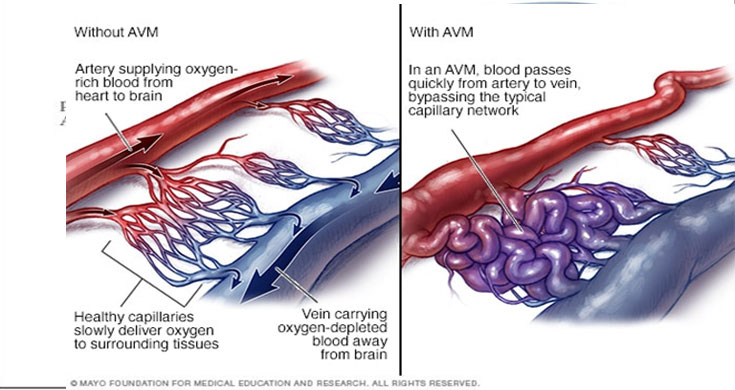
Cerebral Arteriovenous malformation (AVM)
Arteriovenous malformations (AVMs) of the brain refer to abnormal connections between arteries and veins bypassing the normal capillary network to the brain parenchyma.
Brain AVMs commonly present with seizures or epilepsy which generally gets controlled with anti-epileptic drugs. However is some cases it may cause bleeding into or around the brain, most commonly in young adults which can cause headache or neurological deficits. Left untreated, there is a risk that they may bleed again causing severe neurologic damage and even death.
Conventionally AVMs were treated with microsurgical excision. Surgical excision of these clusters of vessels is a bloody surgery and often incomplete due to obscuration of surgical filed by bleeding when excision is done with knife /scisors. Moreover, some of the deep located AVMs are difficult to excise without any neurological morbidity. There was always a need of alternative treatment strategy in these complex and large vascular lesions. In recent past two methods came into practice which are minimally invasive. 1- Stereotactic Radiosurgery (SRS9 or Gamma Knife/Cyberknife Radiosurgery. In this under a highly sophisticated equipment Gamma rays radiation is given to the AVM nidus in a precisely defined way through multiple directions to avoid brain injury. This technique if effective in small AVM in about 80% cases over 2 years duration after SRS.
Stereotactic radiosurgery
Stereotactic radiosurgery uses radiation to breakdown the malformation. A beam of radiation is directed towards the malformation for a small duration.
Endovascular AVM Embolisation: Embolization is a method of plugging the nidus of the AVM with glue or other liquid embolic agents like Onyx/Squid etc. under fluoroscopic guidance by a small tube called a flow guided micro-catheter. This method may require multiple microcatheterization to achieve complete results. Sometimes complete AVM embolisation may not be achieved safely in one session and embolisation may be repeated for the second time in some cases. THis require enormous expertise and deep knowledge of the microvascular anatomy and is generally safe to perform in high volume centres by experienced neurointerventionist.
Surgical removal
The patient may need a conventional brain surgery to remove an Arteriovenous Malformation. Depending on the size of the malformation the technique may vary. The malformation is removed through making a window in the patient skull.
